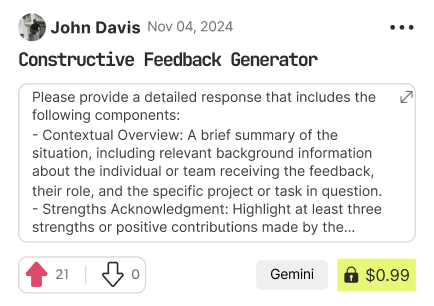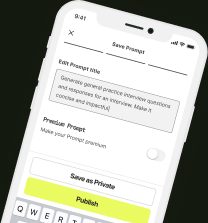prompt mine App
Find, Create & Share AI Magic
Understanding Learning Styles for Enhanced Knowledge Acquisition
Okay, let's dive into the fascinating world of learning styles! As an educational psychologist, I often find that understanding how individuals learn best is a crucial step towards optimizing their learning experiences. It's important to remember that the concept of "learning styles" is a complex and sometimes debated topic. While the idea of tailoring instruction to match a supposed learning style is appealing, research hasn't conclusively proven its effectiveness in isolation. However, understanding preferred ways of processing information can still be helpful in designing more engaging and effective learning strategies. I like to frame it as preferences rather than rigid styles.
Here’s a breakdown of some commonly discussed learning styles and practical tips for improving learning based on these preferences:
**I. Types of Learning Styles and Key Characteristics:**
We'll focus on the widely recognized VARK model, which identifies four primary learning preferences: Visual, Auditory, Read/Write, and Kinesthetic (Tactile).
* **A. Visual Learners:**
* **Key Characteristics:** Visual learners prefer seeing information presented in the form of pictures, diagrams, charts, graphs, and videos. They learn best when they can see the relationships between ideas and concepts. They are often good at spatial reasoning and may remember things based on their visual appearance.
* **Strengths:** Good at remembering visual details, strong spatial reasoning, excellent understanding of maps and diagrams.
* **Challenges:** May struggle with purely auditory information or lengthy text-based explanations without visual aids.
* **B. Auditory Learners:**
* **Key Characteristics:** Auditory learners learn best by listening and speaking. They benefit from lectures, discussions, recordings, and verbal explanations. They are often good at remembering names and faces and may learn by reciting information aloud.
* **Strengths:** Excellent listening skills, good at remembering names and faces, learns well through discussions and lectures.
* **Challenges:** May find it difficult to concentrate in quiet environments or when reading large amounts of text.
* **C. Read/Write Learners:**
* **Key Characteristics:** Read/Write learners prefer to learn through written words. They benefit from reading textbooks, taking notes, writing essays, and creating lists. They enjoy researching and gathering information from written sources.
* **Strengths:** Strong vocabulary, excellent note-taking skills, enjoys writing and reading.
* **Challenges:** May find it difficult to learn from purely visual or auditory sources without written support.
* **D. Kinesthetic (Tactile) Learners:**
* **Key Characteristics:** Kinesthetic learners learn best by doing and experiencing. They benefit from hands-on activities, experiments, simulations, and movement. They need to be actively involved in the learning process.
* **Strengths:** Good at problem-solving through physical activities, strong memory for experiences, learns well through hands-on activities.
* **Challenges:** May find it difficult to sit still for long periods or learn from purely theoretical concepts.
**II. Methods for Identifying an Individual's Preferred Learning Style:**
It's important to note that most people benefit from a blend of learning preferences. Identifying an individual's *preferred* style involves observation, self-reflection, and the use of assessment tools.
* **A. Self-Assessment Questionnaires:** The VARK questionnaire (vark-learn.com) is a readily available and popular tool. Other self-reflection exercises can also be helpful.
* **B. Observational Clues:** Pay attention to how a person naturally approaches learning tasks. Do they prefer to draw diagrams, listen to lectures, read articles, or participate in hands-on activities?
* **C. Experimentation:** Encourage individuals to try different learning strategies and reflect on which ones are most effective and enjoyable for them. Keep a learning journal. Which study methods resulted in the most recall and retention of material?
* **D. Consider Context:** Learning preferences can vary depending on the subject matter or the learning environment. A person might prefer visual learning for understanding geometry but prefer auditory learning for learning a new language.
**III. Practical Tips for Improving Learning for Each Style:**
These tips are designed to enhance learning engagement and retention, not to limit learning to a single style.
* **A. Visual Learners: Enhancing the Visual Experience**
* **Tip 1: Use Visual Aids:** Incorporate diagrams, charts, graphs, maps, and videos into your learning materials.
* **Example:** When learning about the solar system, create a diagram showing the planets' relative sizes and distances from the sun.
* **Tip 2: Mind Mapping:** Use mind mapping techniques to visually organize information and create connections between concepts.
* **Example:** When studying a historical event, create a mind map with the main event at the center and branches for causes, effects, key figures, and related events.
* **Tip 3: Color-Code Notes:** Use different colors to highlight key concepts and categories of information.
* **Example:** In your notes, use blue for definitions, green for examples, and red for important dates.
* **Tip 4: Use flashcards with images:** Put images on flashcards to help you memorize information.
* **Example:** When learning vocabulary, put an image of the word's definition on the flashcard.
* **B. Auditory Learners: Harnessing the Power of Sound**
* **Tip 1: Record Lectures and Discussions:** Listen to recordings of lectures and discussions to reinforce your understanding of the material.
* **Example:** Record your professor's lectures and listen to them while commuting or exercising.
* **Tip 2: Verbalize Information:** Read aloud, explain concepts to others, or engage in discussions to process information verbally.
* **Example:** When studying a complex theory, explain it to a friend or family member in your own words.
* **Tip 3: Use Mnemonics and Rhymes:** Create mnemonics and rhymes to remember facts and information.
* **Example:** Use the mnemonic "My Very Educated Mother Just Served Us Noodles" to remember the order of the planets.
* **Tip 4: Join Study Groups:** Participate in study groups where you can discuss concepts and hear different perspectives.
* **Example:** Form a study group with classmates to discuss readings and practice problem-solving.
* **C. Read/Write Learners: Mastering the Written Word**
* **Tip 1: Take Detailed Notes:** Take thorough notes during lectures and while reading.
* **Example:** When reading a textbook chapter, take detailed notes summarizing the key concepts, definitions, and examples.
* **Tip 2: Write Summaries and Outlines:** Write summaries and outlines of the material to consolidate your understanding.
* **Example:** After reading a chapter, write a one-page summary highlighting the main points.
* **Tip 3: Create Flashcards:** Use flashcards to review key terms and concepts.
* **Example:** Create flashcards with questions on one side and answers on the other to quiz yourself.
* **Tip 4: Write Essays and Research Papers:** Practice writing essays and research papers to deepen your understanding of the subject matter.
* **Example:** Choose a topic related to your course and write a research paper exploring it in detail.
* **D. Kinesthetic Learners: Learning by Doing**
* **Tip 1: Engage in Hands-on Activities:** Participate in experiments, simulations, field trips, and other hands-on activities.
* **Example:** When learning about chemistry, conduct experiments in a laboratory to observe chemical reactions firsthand.
* **Tip 2: Use Manipulatives:** Use physical objects or models to represent abstract concepts.
* **Example:** Use building blocks to understand mathematical concepts or a model of the human body to learn about anatomy.
* **Tip 3: Role-Playing and Simulations:** Participate in role-playing activities and simulations to experience real-world scenarios.
* **Example:** Participate in a mock trial to learn about the legal system or a business simulation to learn about management principles.
* **Tip 4: Take Frequent Breaks and Move Around:** Take frequent breaks to move around and stretch to maintain focus and energy.
* **Example:** Stand up and walk around for a few minutes every 30 minutes of studying.
* **Tip 5: Use Real-World Examples:** Connect learning to real-world applications and experiences.
* **Example:** When learning about physics, relate the concepts to everyday phenomena, such as the way a bicycle works or how a ball bounces.
**Important Considerations:**
* **Learning Styles are Preferences, Not Limitations:** Individuals can learn through all styles, but they may have preferences for certain approaches. Encourage students to experiment and develop a blend of strategies that work best for them.
* **Critical Thinking is Key:** Emphasize the importance of critical thinking skills and encourage students to question, analyze, and evaluate information regardless of their preferred learning style.
* **Adaptability is Essential:** Learning environments and tasks can vary. Students should be able to adapt their learning strategies to meet the demands of different situations.
* **Motivation and Engagement are Crucial:** Learning is most effective when individuals are motivated and engaged. Create a positive and supportive learning environment and provide opportunities for students to pursue their interests and passions.
* **

Understanding Learning Styles for Enhanced Knowledge Acquisition


Find Powerful AI Prompts
Discover, create, and customize prompts with different models, from ChatGPT to Gemini in seconds

Simple Yet Powerful
Start with an idea and use expert prompts to bring your vision to life!